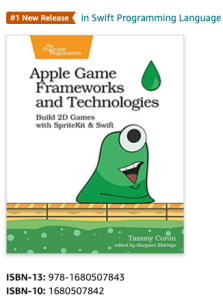Tammy Coron @Paradox927
edited by Margaret Eldridge @margaret
Design and develop sophisticated 2D games that are as much fun to make as they are to play. From particle effects and pathfinding to social integration and monetization, this complete tour of Apple’s powerful suite of game technologies covers it all. Familiar with Swift but new to game development? No problem. Start with the basics and then layer in the complexity as you work your way through three exciting—and fully playable—games. In the end, you’ll know everything you need to go off and create your own video game masterpiece for any Apple platform.
Discover the power of Apple Game Frameworks, Xcode, and Swift by building three exciting games: Gloop Drop—a new twist on a classic arcade game, Val’s Revenge—a roguelike dungeon crawler, and Hog—a social player vs. player mobile dice game. With Apple Game Frameworks, you can create high-performance, power-efficient games that work across all Apple platforms, including iOS, macOS, tvOS, and watchOS.
In this book, you’ll discover how to…
Design and develop rich 2D gaming experiences using Apple’s built-in game frameworks. Harness the power of SpriteKit using Xcode and Swift to create engaging player experiences. Use the visual Scene Editor to build complete scenes. Unleash the power of the Particle Editor to create amazing effects. Use GameplayKit to add advanced features to your games like pathfinding, artificial intelligence, and complex rule systems. Build larger, more complex worlds with tile maps and Xcode’s visual Tile Map editor. Bring people together using GameKit and Game Center, Apple’s social gaming network. Increase revenue with third-party banner ads and rewarded ads using Google AdMob™. Monetize your games with StoreKit and in-app purchases.
So, grab your gear and get your game on—it’s time to level up your skills.
Tammy Coron is an independent creative professional and the maker behind the AdventureGameKit, a custom SpriteKit framework for building point and click adventure games. As an author, editor, illustrator, and indie game developer, Tammy spends her time creating content and teaching others.
- Full details: https://pragprog.com/titles/tcswift/apple-game-frameworks-and-technologies/
- View this book’s portal and details on how to post errata and suggestions here.
Don’t forget you can get 35% off with your Devtalk discount! Just use the coupon code “devtalk.com" at checkout ![]()









